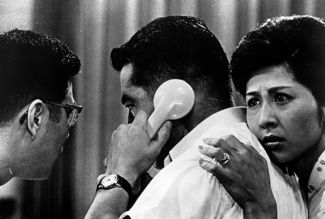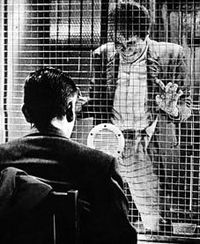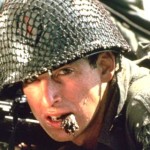 Akira Kurosawa wasn’t known for film noir or crime thrillers, but he did do a genre drive-by back in 1963. Of course, it’s killer.
Akira Kurosawa wasn’t known for film noir or crime thrillers, but he did do a genre drive-by back in 1963. Of course, it’s killer.
The Criterion Collection has reissued to Blu-ray “High and Low,” the Japanese master’s tale of a hardworking factory chief whose life is ruined after his son is targeted by kidnappers. Toshiro Mifune plays shoe executive Kingo Gondo, in another nuanced powerhouse performance.
In Japan, the movie was more descriptively called “Heaven and Hell” — heaven being the exec’s life of comfort atop a mansion on a hill; hell, the lot of the post-war poor who swelter below his air conditioned digs.
“The kidnapper’s right,” one cop says, as he stalks the villains through the heat and garbage. “That house gets on your nerves.”
I first saw this lesser-known Kurosawa film in the big Egyptian theater in Hollywood, a rare treat since “High and Low” makes dramatic, carefully crafted use of the widescreen format. (Martin Scorsese has said the film greatly affected his compositions.) Much is lost on smaller screens, but Criterion’s new HD presentation has plenty of impact.
Kurosawa lovers who own the 2008 Criterion DVDs shouldn’t rush to update, however. While the upgraded HD video and (HD-Master) audio have an elegance missing from the older double-DVD edition — as in, grain seems more artistic; contrasts are not as blunt; the sound is smoother — the differences probably won’t wow many viewers. The 2008 “High and Low” DVD still looks terrific, especially up-converted.
Owners of the 1998 Criterion “High and Low” should make their move, however. That version came barebones, with a booklet and a just-OK video presentation that wasn’t anamorphic.
 Extras on the Blu-ray “High and Low” are ported over from the latter DVD, this time fitting on one disc. Notably, there’s a 37-minute docu from the fine Toho series “Akira Kurosawa: It Is Wonderful to Create” (someone needs to release all of those in a box). Most of the cast and crew’s recollections are about the demands for perfection from Kurosawa, who was just coming off the highs of “Sanjuro” and “Yojimbo.”
Extras on the Blu-ray “High and Low” are ported over from the latter DVD, this time fitting on one disc. Notably, there’s a 37-minute docu from the fine Toho series “Akira Kurosawa: It Is Wonderful to Create” (someone needs to release all of those in a box). Most of the cast and crew’s recollections are about the demands for perfection from Kurosawa, who was just coming off the highs of “Sanjuro” and “Yojimbo.”
Kurosawa deliberately infected his cast and crew with tension as he engineered two long, unforgiving one-shots — in the exec’s living room and on a speeding train. No one dared screw up. Mifune later said he couldn’t properly loop the train scene because he’d nervously raced through his lines as it was shot. The production-wide jitters carried over to the screen, as the director planned.
The Blu-ray’s detailed commentary comes from Stephen Prince (author of the Kurosawa book “The Warrior’s Camera”), who did equally fine talks on “Kagemusha.” He reads his material and tends to over-explain, but the talk richly rewards those who stick with it.
Prince spends a lot of time on the camera angles and other optical considerations. “This is one of the all-time great examples of widescreen filmmaking,” he says. “It redefines the look of all later Kurosawa (films).”
Images are in the original 2.35:1 (Tohoscope, go figure). Some incidental damage remains on the video, such as flashing and minor scratches … nothing to fret about. The audio scheme remains front-centered, with occasional blasts to the supporting speakers (such as the wail of a train whistle).
The movie is based on a 1959 Ed McBain book, “King’s Ransom,” one of the lesser 87th Precinct tales. Kurosawa, not surprisingly, neutered some of the Rambo elements. He retained the plot basics: the kidnapping plot goes haywire as the crooks mistakenly grab the chauffeur’s kid. The rich exec then must decide if he’ll pay the ransom for his servant’s child, ensuring the collapse of his own personal and professional life.
The moral of the “High and Low” story is, in fact, the opposite of McBain’s. Prince notes that Kurosawa was “rejecting and remaking (the book’s) core values.”
The black-and-white film’s first half plays like a stage play, the drama contained within Gondo’s modern living room. Gondo’s rivals in a corporate takeover battle come and go, along with the cops. The second half gets down to street level, where we shadow police detectives as they work the highly publicized case. The trail leads through the slums, G.I. bars, whorehouses and dope-shooting galleries.
In addition to the film’s (quite obvious) 50/50 structure, there are the traditional three acts: the kidnapping, the rescue attempts and then the hardcore manhunt.
 Much of the film is a cracker-jack police procedural. (It supposedly was used as training material for Tokyo police.)
Much of the film is a cracker-jack police procedural. (It supposedly was used as training material for Tokyo police.)
Two key performances come from Tatsuya Nakadai (terrific as the modern chief detective) and Kenjiro Ishiyama (playing a bald, old-school bulldog of a lawman). Kurosawa rode Ishiyama mercilessly, ultimately getting a great performance from an average actor. Again, Kurosawa overrules McBain, as the Japanese lawmen become dedicated to saving the suffering executive instead of victimizing him.
Kurosawa’s layers of complexity and sensitivity do nothing to filter the hardcore truths at the story’s core.
The director took up the project partly because of a series of horrific Japanese kidnappings in the early ’60s that resulted the murders of children. “High and Low” inspired legislation that greatly increased penalties for ransom crimes.
There can be no mistaking the warning issued in the chilling final frames, as the steel door slams shut.
* * * * *
Viewers should set aside time for the bonus chat-show footage with Mifune, first broadcast not too long after the worldwide success of “Shogun.” The TV show comes wrapped in fluff but the content is terrific.
The stylish hostess calls Mifune “the pride of Japan,” but notes that he “cleans his own production office.” The great actor replies, “Poor men have no leisure.”
Mifune tells his audience that the foreign filmmakers with which he’d been working (“Shogun,” “Inchon”) had some “funny ideas about Japan” and had to be set straight.
Mifune talks about how he left the army with “two blankets and 1 yen” before finding a job at Toho. He tried out for acting work, refusing to smile in auditions because there wasn’t much to smile about: “I was accepted as an oddball, out of mercy.”
Related reviews:
Check out Glenn Abel on Google+



Leave a Reply